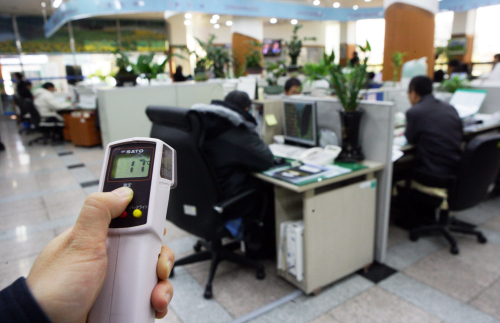The government is introducing a series of contingency measures to cut power consumption as the cold spell drives up electricity demand to record levels.
With the cold snap gripping the nation, even in the warmer southern regions, electricity demand has shot up, setting new records three times already this month.
On Monday, the country’s electricity demand shot up to greater than 7.3 million kilowatt hours, breaking the previous record set on Jan. 10, which was about 400,000 kilowatt higher than the record of Jan 7.
With the rise in consumption, Korea’s generating capacity is being pushed to its limits, fueling concerns of a power shortage.
On Monday, the country’s reserve capacity was pushed down to 5.5 percent, far short of the 10 percent line considered to provide a sufficient buffer for times of high demand such as the summer and winter months.

In addition, a power cut that occurred at an industrial complex in Yeosu, South Jeolla Province on Monday is fuelling worries that the surge in demand could lead to similar incidences in other such complexes.
On Monday, power to the complex was cut for about 20 minutes. While power was out for a relatively short period of time, damages sustained by companies operating in the area, including the refiner GS Caltex, are estimated to run into tens if not hundreds of billions of won.
As such, related issues have become a topic of urgent discussion at the highest level of government.
“It is important to carry out energy-saving measures in response to high oil prices and rapidly rising electricity consumption,” President Lee Myung-bak said at a Cabinet meeting on Tuesday. He added that a policy that has been established once needs to form the basis for the next, and therefore efforts must be made to become more efficient in saving energy this year using the experience of related measures from last year.
Lee also urged concerned government bodies to closely monitor the execution of related measures and firmly establish such practices.
On Monday, the government announced emergency plans to cut energy consumption that limits the temperature to 18 degrees Celsius at all government buildings. The measure also prohibits the use of personal electric heaters, and calls for heaters to be switched off from 11 a.m. to midday, and then again from 5 p.m. until 6 p.m.
Similar measures that prohibit temperatures from exceeding 20 degrees Celsius will also be applied to 441 large buildings including department and discount stores from Jan. 24.
In addition, the interval between subway trains will be increased by 1 to 3 minutes between 10 a.m. and midday. The Ministry of Land, Transport and Maritime Affairs is in charge of measures regarding subway trains, which will be implemented according to changes in electricity consumption.
However, such measures are temporary and will not be able to provide a fundamental solution to a problem arising year after year during both the coldest and hottest months.
Although the government has revealed plans to massively increase Korea’s generating capacity, it may be some time before the country will be able to put concerns over power shortages completely behind it.
According to the government’s electricity supply plan, 49 trillion won ($44 billion) will be injected into increasing the country’s generating capacity to 112.59 gigawatts by 2024, up nearly 56 percent from 2009’s capacity of 72.26 gigawatts.
Over the period the government expects electricity consumption to grow at an annual average of 1.9 percent to reach 551.6 billion kilowatt hours in 2024 from 423.8 billion kilowatt hours recorded last year.
While the country will have a more-than-sufficient reserve capacity of 18.2 percent by the end of the plan, the figure will remain below 10 percent at least until 2014, leaving the country open to repeats of this winter.
By Choi He-suk (cheesuk@heraldcorp.com)
<한글 기사>
방심은 금물..전기 '스마트'하게 쓰자
"피크 타임은 지나갔지만, 전력난을 피할 '스마트'한 전기사용이 절실합니다."
한파가 잠시 주춤하면서, 일단 전력 수급도 안정을 되찾는 모습이다.
지난 18일 최대전력수요는 7천220만㎾. 여전히 높지만 7천313만7천㎾를 기록하며 정점을 찍었던 17일 정오와 비교하면 확실히 한 풀 꺾였다.
그러나 관계부처와 유관 기관들은 비상 사태가 올지 모른다는 가정아래 긴장을 늦추지 않는 모습이다.
김정관 지식경제부 에너지자원정책실장은 19일 "17일 정오 기록한 7천313만7천㎾를 올 겨울 전체 피크로 보고 있다"며 "그러나 불요불급한 전기 사용은 자제하고 긴장을 늦추지 말아야 한다"고 말했다.
김 실장은 먼저 "열흘 넘게 이상 한파가 계속되며 전력수요가 급증했던 것인 만큼, 일단 추위가 한 번 주춤하면 전력수요가 더 이상 올라가지는 않을 것"이라고 내다봤다.
하지만 그는 피크 시간대인 오전 10시부터 낮 12시, 오후 4시부터 6시까지는 난방기 사용을 자제하는 등 '스마트'한 전기 소비가 필요하다고 강조했다.
지경부와 한전은 일단 전력 예비력이 400만㎾ 이하로 내려가지 않도록 관리하는데 주력하고 있다.
금주부터 이미 대형 전력소비기업 930개를 대상으로 부하 관리에 들어가 180만㎾ 정도 추가 전력을 확보한 상황이다.
내주부터는 백화점과 에너지 다소비 건물 441곳을 대상으로 본격적인 난방온도 제한 조치에 들어간다.
일부 사업장을 대상으로 확대하고 있는 점심시간 한 시간 앞당기기 캠페인도 나름대로 효과를 톡톡하게 내고 있다고 한다.
또 오는 25일로 예정된 신고리 원전 개보수를 가능한 한 조기에 마무리해 빠르면 20일부터 가동할 방침이다.
나아가 고급탄 사용 등을 통해 기존 발전소의 출력을 최고 수준까지 높이면 예비력 확보에는 큰 문제가 없다는 것이 한국전력공사의 설명이다.
김동섭 한전 수요개발팀장은 "앞으로 최대 전력수요는 7천200만㎾ 안쪽에서 왔다갔다할 것으로 예측한다"며 "에너지 다소비 기업에 대한 부하관리와 변압기 전압조정, 기업들의 자체적인 점심시간 조정 등을 통해 어느 정도 안정적인 예비율 관리가 가능한 것으로 보고 있다"고 말했다.
김 팀장은 "추가 발전소가 건설되는 2013년부터는 어느 정도 여유가 생기는 것이 사실이지만, 발전소 추가 건설은 결국 전기요금 인상과 연결되는 만큼 전기를 아껴쓰는 것이 가장 중요하다"고 강조했다.
그러면서 "현재까지는 대규모 공장 위주로 감축 프로그램을 진행했지만, 소규모 상가와 음식점 등의 난방 수요를 잘 관리해 전기 절약을 확대하는 방안도 강구해야한다"고 덧붙였다. (연합뉴스)







![[Graphic News] More Koreans say they plan long-distance trips this year](http://res.heraldm.com/phpwas/restmb_idxmake.php?idx=644&simg=/content/image/2024/04/17/20240417050828_0.gif&u=)
![[KH Explains] Hyundai's full hybrid edge to pay off amid slow transition to pure EVs](http://res.heraldm.com/phpwas/restmb_idxmake.php?idx=644&simg=/content/image/2024/04/18/20240418050645_0.jpg&u=20240419100350)





![[From the Scene] Monks, Buddhists hail return of remains of Buddhas](http://res.heraldm.com/phpwas/restmb_idxmake.php?idx=652&simg=/content/image/2024/04/19/20240419050617_0.jpg&u=20240419175937)

![[KH Explains] Hyundai's full hybrid edge to pay off amid slow transition to pure EVs](http://res.heraldm.com/phpwas/restmb_idxmake.php?idx=652&simg=/content/image/2024/04/18/20240418050645_0.jpg&u=20240419100350)

![[Today’s K-pop] Illit drops debut single remix](http://res.heraldm.com/phpwas/restmb_idxmake.php?idx=642&simg=/content/image/2024/04/19/20240419050612_0.jpg&u=)